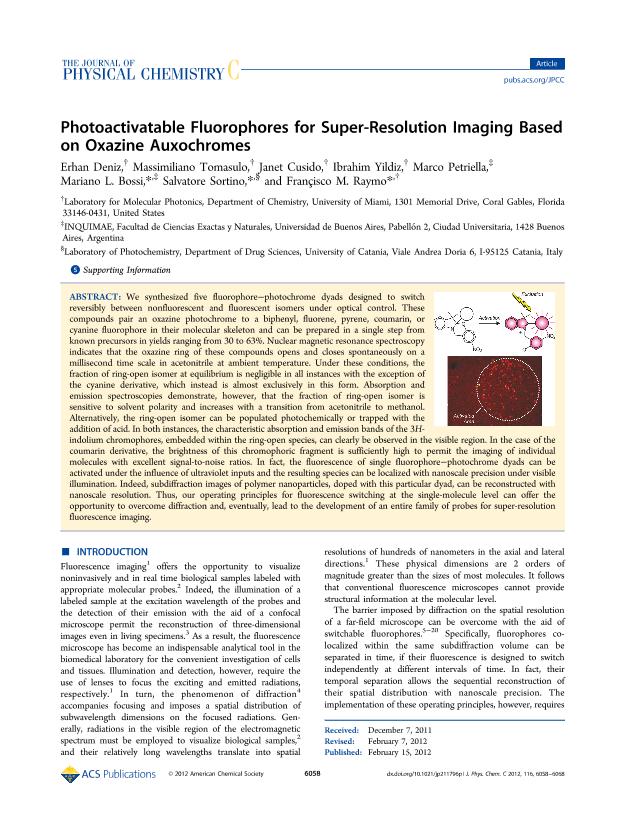Mostrar el registro sencillo del ítem
dc.contributor.author
Deniz, Erhan
dc.contributor.author
Tomasulo, Massimiliano
dc.contributor.author
Cusido, Janet
dc.contributor.author
Yildiz, Ibrahim
dc.contributor.author
Petriella, Marco

dc.contributor.author
Bossi, Mariano Luis

dc.contributor.author
Sortino, Salvatore
dc.contributor.author
Raymo, Françisco M.
dc.date.available
2019-01-09T18:54:03Z
dc.date.issued
2012-03
dc.identifier.citation
Deniz, Erhan; Tomasulo, Massimiliano; Cusido, Janet; Yildiz, Ibrahim; Petriella, Marco; et al.; Photoactivatable Fluorophores for Super-Resolution Imaging Based on Oxazine Auxochromes; American Chemical Society; Journal of Physical Chemistry C; 116; 10; 3-2012; 6058-6068
dc.identifier.issn
1932-7447
dc.identifier.uri
http://hdl.handle.net/11336/67811
dc.description.abstract
We synthesized five fluorophore-photochrome dyads designed to switch reversibly between nonfluorescent and fluorescent isomers under optical control. These compounds pair an oxazine photochrome to a biphenyl, fluorene, pyrene, coumarin, or cyanine fluorophore in their molecular skeleton and can be prepared in a single step from known precursors in yields ranging from 30 to 63%. Nuclear magnetic resonance spectroscopy indicates that the oxazine ring of these compounds opens and closes spontaneously on a millisecond time scale in acetonitrile at ambient temperature. Under these conditions, the fraction of ring-open isomer at equilibrium is negligible in all instances with the exception of the cyanine derivative, which instead is almost exclusively in this form. Absorption and emission spectroscopies demonstrate, however, that the fraction of ring-open isomer is sensitive to solvent polarity and increases with a transition from acetonitrile to methanol. Alternatively, the ring-open isomer can be populated photochemically or trapped with the addition of acid. In both instances, the characteristic absorption and emission bands of the 3H-indolium chromophores, embedded within the ring-open species, can clearly be observed in the visible region. In the case of the coumarin derivative, the brightness of this chromophoric fragment is sufficiently high to permit the imaging of individual molecules with excellent signal-to-noise ratios. In fact, the fluorescence of single fluorophore-photochrome dyads can be activated under the influence of ultraviolet inputs and the resulting species can be localized with nanoscale precision under visible illumination. Indeed, subdiffraction images of polymer nanoparticles, doped with this particular dyad, can be reconstructed with nanoscale resolution. Thus, our operating principles for fluorescence switching at the single-molecule level can offer the opportunity to overcome diffraction and, eventually, lead to the development of an entire family of probes for super-resolution fluorescence imaging. © 2012 American Chemical Society.
dc.format
application/pdf
dc.language.iso
eng
dc.publisher
American Chemical Society

dc.rights
info:eu-repo/semantics/openAccess
dc.rights.uri
https://creativecommons.org/licenses/by-nc-sa/2.5/ar/
dc.subject
Fluorescence
dc.subject
Photochemistry
dc.subject
Photoswitching
dc.subject
Nanoscopy
dc.subject.classification
Otras Ciencias Químicas

dc.subject.classification
Ciencias Químicas

dc.subject.classification
CIENCIAS NATURALES Y EXACTAS

dc.title
Photoactivatable Fluorophores for Super-Resolution Imaging Based on Oxazine Auxochromes
dc.type
info:eu-repo/semantics/article
dc.type
info:ar-repo/semantics/artículo
dc.type
info:eu-repo/semantics/publishedVersion
dc.date.updated
2019-01-02T19:09:52Z
dc.journal.volume
116
dc.journal.number
10
dc.journal.pagination
6058-6068
dc.journal.pais
Estados Unidos

dc.journal.ciudad
Washington
dc.description.fil
Fil: Deniz, Erhan. University of Miami; Estados Unidos
dc.description.fil
Fil: Tomasulo, Massimiliano. University of Miami; Estados Unidos
dc.description.fil
Fil: Cusido, Janet. University of Miami; Estados Unidos
dc.description.fil
Fil: Yildiz, Ibrahim. University of Miami; Estados Unidos
dc.description.fil
Fil: Petriella, Marco. Consejo Nacional de Investigaciones Científicas y Técnicas. Oficina de Coordinación Administrativa Ciudad Universitaria. Instituto de Química, Física de los Materiales, Medioambiente y Energía. Universidad de Buenos Aires. Facultad de Ciencias Exactas y Naturales. Instituto de Química, Física de los Materiales, Medioambiente y Energía; Argentina
dc.description.fil
Fil: Bossi, Mariano Luis. Consejo Nacional de Investigaciones Científicas y Técnicas. Oficina de Coordinación Administrativa Ciudad Universitaria. Instituto de Química, Física de los Materiales, Medioambiente y Energía. Universidad de Buenos Aires. Facultad de Ciencias Exactas y Naturales. Instituto de Química, Física de los Materiales, Medioambiente y Energía; Argentina
dc.description.fil
Fil: Sortino, Salvatore. University of Catania; Italia
dc.description.fil
Fil: Raymo, Françisco M.. University of Miami; Estados Unidos
dc.journal.title
Journal of Physical Chemistry C

dc.relation.alternativeid
info:eu-repo/semantics/altIdentifier/url/https://pubs.acs.org/doi/10.1021/jp211796p
dc.relation.alternativeid
info:eu-repo/semantics/altIdentifier/doi/https://dx.doi.org/10.1021/jp211796p
Archivos asociados
